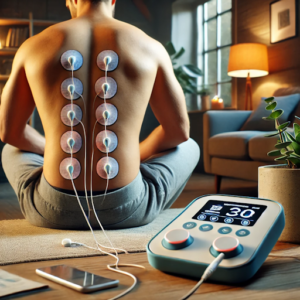Effectively Managing Back Pain Through Electrotherapy
Back pain is a widespread issue affecting millions worldwide, transcending age, gender, and lifestyle factors. It can manifest in various ways, from sharp discomfort lasting a few days to chronic pain that persists for months or years. Often, back pain stems from a combination of physical, psychological, and environmental factors.
Common causes of back pain include muscle strain, herniated discs, arthritis, and poor posture. The variability in how back pain is experienced complicates diagnosis and treatment. While some may find the pain tolerable, others could be severely debilitated, requiring a comprehensive approach from healthcare professionals.
Beyond physical health, chronic back pain can take a toll on emotional well-being, often leading to anxiety, depression, and social isolation. The economic implications are substantial, as back pain is one of the leading causes of disability and reduced productivity in workplaces.
Understanding the underlying causes of back pain is crucial for developing effective treatment strategies. One such strategy is electrotherapy, which has gained recognition for its ability to relieve pain and promote recovery.
Summary
- Back pain may result from factors like poor posture, muscle strain, or injury and significantly impact daily life.
- Electrotherapy is a non-invasive technique that uses electrical energy to manage pain and promote healing.
- Electrotherapy offers pain relief, muscle relaxation, improved circulation, and reduced inflammation.
- Different electrotherapy methods like TENS and EMS can help alleviate back pain.
- When using electrotherapy, it’s important to follow healthcare professional advice and avoid using it near the heart or on broken skin.
 Introduction to Electrotherapy
Introduction to Electrotherapy
Electrotherapy refers to various techniques that use electrical energy to treat conditions like back pain. This therapeutic approach has evolved, utilizing advanced technologies to offer pain relief and promote healing. Electrotherapy can target specific areas of discomfort by stimulating nerves and muscles through electrical impulses.
Unlike medications, which may cause side effects or dependency, electrotherapy is non-invasive and effective in managing back pain. As research continues, the benefits of electrotherapy are becoming more widely recognized, leading to its integration into comprehensive pain management plans.
Benefits of Electrotherapy for Back Pain
One of the primary benefits of electrotherapy is its ability to provide immediate pain relief. Elect electrotherapy interrupts pain signals by sending electrical impulses to the affected area, reducing discomfort.
Additionally, it promotes the release of endorphins, the body’s natural pain relievers, further enhancing its effectiveness. Electrotherapy also improves blood circulation and reduces inflammation, supporting the healing process. This combination of immediate and long-term benefits makes electrotherapy a valuable tool for managing back pain.
Types of Electrotherapy for Back Pain
Electrotherapy encompasses various methods, each targeting different aspects of back pain management. TENS (Transcutaneous Electrical Nerve Stimulation) is a popular technique that delivers low-voltage electrical currents to relieve pain. Its portability and ease of use make it ideal for home treatment.
IFC (Interferential Current Therapy) uses medium-frequency electrical currents to reach deeper tissues and address musculoskeletal issues. Additionally, EMS (Electrical Muscle Stimulation) and microcurrent therapy are increasingly recognized for stimulating muscle contractions and aiding tissue repair.
 How to Use Electrotherapy for Back Pain Management
How to Use Electrotherapy for Back Pain Management
Following specific guidelines is crucial to ensuring safety and effectiveness when using electrotherapy. Patients should consult a healthcare provider to determine the best electrotherapy option. Once a treatment plan is in place, therapy can be administered in a clinical setting or with portable devices at home.
Home users must follow the manufacturer’s instructions for electrode placement, intensity, and session duration. A typical session lasts between 20 and 60 minutes. Consistency is key, as regular treatments offer cumulative benefits over time. Regular communication with a healthcare provider is essential to track progress and make adjustments if needed.
Precautions and Considerations When Using Electrotherapy
Although electrotherapy is generally safe, certain precautions should be taken to avoid complications. Individuals with heart disease, epilepsy, or implanted devices like pacemakers should consult a healthcare provider before using electrotherapy. Pregnant women are also advised to avoid electrotherapy near the abdomen or lower back.
It is important to avoid placing electrodes on open wounds or infected areas. Patients should also monitor their bodies for adverse reactions during treatment and stop immediately if they experience increased pain or skin irritation.
 Integrating Electrotherapy with Other Back Pain Management Techniques
Integrating Electrotherapy with Other Back Pain Management Techniques
Integrating electrotherapy with other treatments can enhance back pain management. A holistic approach often yields better results than relying on a single therapy. Combining electrotherapy with physical therapy can strengthen muscles and improve flexibility while addressing underlying musculoskeletal problems.
Making ergonomic adjustments at work or home can further enhance the benefits of electrotherapy by reducing strain on the back. Additionally, incorporating stress-reducing practices like yoga or meditation can help alleviate pain perception by promoting relaxation.
FAQs
Can you tell me about electrotherapy for back pain?
Electrotherapy uses electrical stimulation to manage and relieve back pain—standard methods in inStandardTENS and EMS.
How might electrotherapy help with my back pain?
Electrotherapy stimulates nerves and muscles to improve blood flow, promote healing, block pain signals, and trigger the production of endorphins, the body’s natural painkillers.
Is it safe to use electrotherapy for back pain?
Electrotherapy is generally safe when guided by a trained healthcare provider. Follow recommended protocols and avoid applying the device near the head or heart.
How does electrotherapy work for back pain?
Electrotherapy relieves pain, reduces muscle spasms, and improves flexibility. It’s a non-invasive and drug-free option for managing back pain.
Who can benefit from electrotherapy for back pain?
Electrotherapy may benefit individuals with conditions such as strained muscles, arthritis, sciatica, or herniated discs as part of a broader pain management strategy.
Are there any situations where electrotherapy isn’t recommended?
Electrotherapy is not recommended for individuals with pacemakers, epilepsy, or heart conditions. Consult a doctor before starting treatment.
Brought To You By: Back Pain Therapy
The Article: Managing Back Pain with Electrotherapy appeared first on https://mcrtherapies.co.uk
The Article Managing Back Pain with Electrotherapy appeared first on https://mcrtherapies.com
The Article Managing Back Pain with Electrotherapy Was Found On https://limitsofstrategy.com


This is such an important topic, as managing back pain is not just about alleviating physical discomfort; it’s about reclaiming quality of life. I’ve personally experienced the challenges of chronic back pain, and it’s fascinating to see how many aspects it can impact—both physically and emotionally.
It’s interesting to see how back pain can be such a multifaceted issue, touching on physical, psychological, and even societal realms. I’ve personally struggled with back pain for a number of years, mostly stemming from long hours spent at a desk job. Initially, I dismissed it as something that would just go away with a bit of rest, but over time, I realized it needed a more proactive approach. It’s fascinating (and a little daunting) to consider how many people are dealing with similar challenges daily.
You bring up such an important point about the multifaceted nature of back pain. It’s so easy to underestimate how much our lifestyle can contribute to it, especially in a world that often prioritizes productivity over well-being. Your experience with trying to dismiss it as something that would pass resonates with me; I went through a similar phase. I was caught up in the daily grind and thought that with a little stretching and some rest, I’d be fine.
I can relate to that struggle and found some insights in an article about how red light therapy might offer a new avenue for relief, blending the physical, psychological, and societal aspects of dealing with back pain.
‘Back Pain Relief with Red Light Therapy’
https://lonelyspooky.com/back-pain-relief-with-red-light-therapy/.
You’re spot on about the balance between productivity and well-being. It’s so ingrained in our culture to push through discomfort, especially when we’re busy. I faced a similar situation where I kept rationalizing my back pain, thinking that it was just a temporary setback. It wasn’t until I started to truly listen to my body that I realized how much I was overlooking.
Your exploration of back pain and its multifaceted impact is a critical reminder of how intricate our health issues can be. I’ve experienced periods of significant back pain myself, which opened my eyes to how deeply it can affect not just physical mobility but overall well-being, including mental health and social interactions.
It’s interesting how back pain can become such a pivotal point in our lives, isn’t it? Your experience really resonates with me, especially regarding the connection between physical discomfort and mental well-being. I’ve noticed that when I or someone close to me is dealing with chronic pain, it often changes daily routines and how we relate to friends and family. It’s not just the pain itself but all the little implications that come with it—like having to decline social invitations or being less engaged in activities we once loved.
It’s really interesting how back pain can be a powerful lens through which we see the intricacies of health. Your experience resonates with many who struggle with chronic pain. It’s true that the impact goes beyond just physical limitations. I remember my own bouts with back issues and how they sometimes led to feelings of isolation. It changes not just how you move but how you engage with the world, which can be so frustrating.
It’s fascinating how our experiences with back pain can really shape our perspective on overall health, isn’t it? Your point about feeling isolated during tough times strikes a chord with me. It can feel like an invisible barrier between you and the life you want to lead. I remember the days when even small social gatherings felt daunting, just because I wasn’t sure how my body would respond.
It really is fascinating how back pain can shift our perspective on health and well-being. It’s like this uninvited guest that changes how we interact with the world. I completely understand the feeling of isolation that can come with it; those invisible barriers can be incredibly challenging. I remember having to cancel plans more times than I can count, just the thought of being in a crowded space while not feeling my best felt so overwhelming.
You’ve captured a crucial aspect of dealing with back pain that often gets overlooked—the emotional and social dimensions. Chronic pain is not just a physical experience; it has a remarkable way of reshaping how we interact with the world and the people in it.
Your experience resonates deeply and highlights a truth that often gets overshadowed in discussions about back pain: the ways it can ripple through various aspects of our lives. When we think about back pain, it’s easy to focus solely on the physical aspect—like the discomfort and limitations on movement. Yet, as you’ve pointed out, the emotional and social ramifications can be just as significant.
This post sheds light on an often-overlooked aspect of back pain—the emotional toll it can take. I’ve experienced this firsthand; dealing with chronic back pain not only affected my physical ability to work but also my mental health. It’s fascinating how interconnected these dimensions are.
Your exploration of back pain and its multifaceted nature resonates deeply with many who have faced the distressing impact of this condition on both physical and emotional health. Having dealt with back pain myself for several years, it has become clear to me how essential it is to take a holistic approach to management. While the discomfort can sometimes feel isolating, knowing that millions share this struggle is oddly comforting; it underscores the universality of the issue.
Your experience highlights a crucial aspect of back pain that often goes overlooked: the emotional toll it can take alongside the physical challenges. Many people find themselves submerged in feelings of frustration or isolation when dealing with ongoing discomfort, which can create a sense of disconnection from daily activities and even from loved ones. Understanding this emotional dimension is vital to addressing what back pain truly entails.
Your coverage of back pain as a multifaceted issue is spot on. I’ve personally dealt with chronic back pain for years, and it’s staggering how it not only affects physical health but spills into emotional and social aspects of life. It’s interesting to consider how societal attitudes towards pain can influence a person’s willingness to seek treatment. For example, there’s still a stigma around discussing chronic pain as a legitimate health issue, often leading to feelings of isolation.